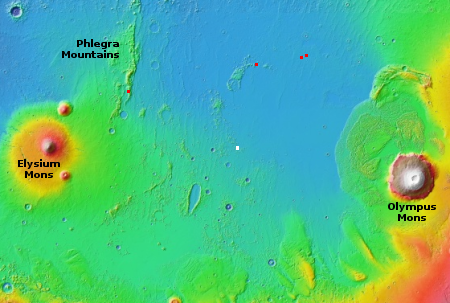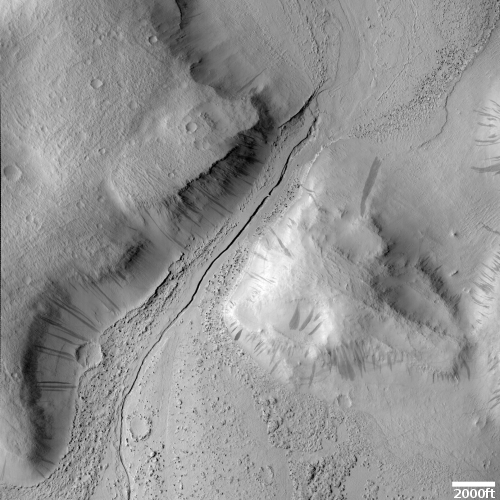Many of Mars’ geological mysteries, all in one photo
Today’s cool image is fun because it contains a plethora of Martian mysteries, all packed into a very small space. The photo to the right was taken on April 29, 2021 by the high resolution camera on Mars Reconnaissance Orbiter (MRO). I have rotated, cropped, and reduced it to post here.
The uncaptioned picture was labeled “Small Channel Winding between Knobs in Tartarus Colles.” The knobs, which can be seen on either side of the thin channel within the canyon, are actually a major Martian puzzle. Tartarus Colles has a lot of them, and planetary geologists are not really sure how they formed. One 2009 paper [pdf] suggested that the cones were formed by the violent interaction of lava and ice. This earlier paper [pdf] hypothesized that both water and lava had to be flowing over the surface at the same time, producing the steam and the energy that popped the lava cones, kind of like the small convection bubbles seen when tomato sauce simmers.
The scientific literature however is not deep, and there appears to be much uncertainty about this conclusion.
The photo however contains other major Martian puzzles.
For example, the canyon slopes on either side of the channel are filled with what look like either slope streaks or recurring slope lineae, both Martian features that are unique to the Red Planet. At first scientists thought that they were seeing some form of salt water brine seepage coming out of cliff faces. Now they are tending to favor the theory that some form of weird dust avalanches cause the streaks.
Neither theory is proven or accounts for all the facts.

The channel itself is thought to be a flood lava flow, one of many that seem to cover the entire region between the two giant shield volcanoes Elsyium and Olympus Mons, shown on the overview map to the right. The white dot marks the location in Tartarus Colles of this image. The four red dots about five hundred miles to the north are the four prime candidate landing sites for SpaceX’s Starship spacecraft.
The latitude is 24 degrees north, placing this in Mars’ dry equatorial regions. Though lava therefore is the likely explanation for these flows and channels, not water, the specifics of the geology remain puzzling. The reason for a narrow inner channel within the larger one is unclear, though this is might be related to the fact that Martian lava moves much much faster than on Earth, due to the low gravity.
I am sure there are further mysteries buried in this single picture. The deeper you look, the more you will see.
On Christmas Eve 1968 three Americans became the first humans to visit another world. What they did to celebrate was unexpected and profound, and will be remembered throughout all human history. Genesis: the Story of Apollo 8, Robert Zimmerman's classic history of humanity's first journey to another world, tells that story, and it is now available as both an ebook and an audiobook, both with a foreword by Valerie Anders and a new introduction by Robert Zimmerman.
The print edition can be purchased at Amazon or from any other book seller. If you want an autographed copy the price is $60 for the hardback and $45 for the paperback, plus $8 shipping for each. Go here for purchasing details. The ebook is available everywhere for $5.99 (before discount) at amazon, or direct from my ebook publisher, ebookit. If you buy it from ebookit you don't support the big tech companies and the author gets a bigger cut much sooner.
The audiobook is also available at all these vendors, and is also free with a 30-day trial membership to Audible.
"Not simply about one mission, [Genesis] is also the history of America's quest for the moon... Zimmerman has done a masterful job of tying disparate events together into a solid account of one of America's greatest human triumphs."--San Antonio Express-News
Today’s cool image is fun because it contains a plethora of Martian mysteries, all packed into a very small space. The photo to the right was taken on April 29, 2021 by the high resolution camera on Mars Reconnaissance Orbiter (MRO). I have rotated, cropped, and reduced it to post here.
The uncaptioned picture was labeled “Small Channel Winding between Knobs in Tartarus Colles.” The knobs, which can be seen on either side of the thin channel within the canyon, are actually a major Martian puzzle. Tartarus Colles has a lot of them, and planetary geologists are not really sure how they formed. One 2009 paper [pdf] suggested that the cones were formed by the violent interaction of lava and ice. This earlier paper [pdf] hypothesized that both water and lava had to be flowing over the surface at the same time, producing the steam and the energy that popped the lava cones, kind of like the small convection bubbles seen when tomato sauce simmers.
The scientific literature however is not deep, and there appears to be much uncertainty about this conclusion.
The photo however contains other major Martian puzzles.
For example, the canyon slopes on either side of the channel are filled with what look like either slope streaks or recurring slope lineae, both Martian features that are unique to the Red Planet. At first scientists thought that they were seeing some form of salt water brine seepage coming out of cliff faces. Now they are tending to favor the theory that some form of weird dust avalanches cause the streaks.
Neither theory is proven or accounts for all the facts.

The channel itself is thought to be a flood lava flow, one of many that seem to cover the entire region between the two giant shield volcanoes Elsyium and Olympus Mons, shown on the overview map to the right. The white dot marks the location in Tartarus Colles of this image. The four red dots about five hundred miles to the north are the four prime candidate landing sites for SpaceX’s Starship spacecraft.
The latitude is 24 degrees north, placing this in Mars’ dry equatorial regions. Though lava therefore is the likely explanation for these flows and channels, not water, the specifics of the geology remain puzzling. The reason for a narrow inner channel within the larger one is unclear, though this is might be related to the fact that Martian lava moves much much faster than on Earth, due to the low gravity.
I am sure there are further mysteries buried in this single picture. The deeper you look, the more you will see.
On Christmas Eve 1968 three Americans became the first humans to visit another world. What they did to celebrate was unexpected and profound, and will be remembered throughout all human history. Genesis: the Story of Apollo 8, Robert Zimmerman's classic history of humanity's first journey to another world, tells that story, and it is now available as both an ebook and an audiobook, both with a foreword by Valerie Anders and a new introduction by Robert Zimmerman.
The print edition can be purchased at Amazon or from any other book seller. If you want an autographed copy the price is $60 for the hardback and $45 for the paperback, plus $8 shipping for each. Go here for purchasing details. The ebook is available everywhere for $5.99 (before discount) at amazon, or direct from my ebook publisher, ebookit. If you buy it from ebookit you don't support the big tech companies and the author gets a bigger cut much sooner.
The audiobook is also available at all these vendors, and is also free with a 30-day trial membership to Audible.
"Not simply about one mission, [Genesis] is also the history of America's quest for the moon... Zimmerman has done a masterful job of tying disparate events together into a solid account of one of America's greatest human triumphs."--San Antonio Express-News


